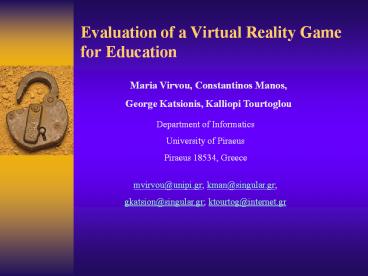Evaluation of a Virtual Reality Game for Education - PowerPoint PPT Presentation
Title:
Evaluation of a Virtual Reality Game for Education
Description:
Evaluation of a Virtual Reality Game for Education Maria Virvou, Constantinos Manos, George Katsionis, Kalliopi Tourtoglou Department of Informatics – PowerPoint PPT presentation
Number of Views:189
Avg rating:3.0/5.0
Title: Evaluation of a Virtual Reality Game for Education
1
Evaluation of a Virtual Reality Game for
Education
Maria Virvou, Constantinos Manos, George
Katsionis, Kalliopi Tourtoglou
Department of Informatics University of
Piraeus Piraeus 18534, Greece
mvirvou_at_unipi.gr kman_at_singular.gr
gkatsion_at_singular.gr ktourtog_at_internet.gr
2
Evaluation of educational software
Evaluation is a crucial part of the design
process of educational software that has to be
iterative to a large extend.
The educational material must be tried out on
students and refined and then tried again and the
cycle continued for as long as necessary (Jones
et al.,1993)
3
The Multi-Tutor Game
- A virtual reality game that teaches students
- several subjects such as mathematics, history,
- geography and spelling.
- It aims at increasing student's engagement by
- providing a popular and motivating VR environment.
4
The Multi-Tutor Game
Each domain is taught in a different VR world
- History is taught in a virtual world of lands
- with castles and warriors.
- Biology is taught in a virtual water
- world.
- Spelling is taught in a virtual world of
- woods.
- Mathematics is taught in a virtual
- world of planets of the outer space.
5
Images
6
The Multi-Tutor Game
- The player tries to reach the
- "land of knowledge" and find the
- treasure which is hidden there.
- To achieve this, the player has to
- obtain a good score, which is
- accumulated by all four domains.
- The game aims at motivating students
- to have a good standard in lessons
- which are different from each other.
7
The Multi-Tutor Game
- Common student modelling component
- for all four domains.
- Error diagnosis The student receives
- points for his/her total score
- depending on the severity of the error.
- Domain independent student features are
- common for all four domains (e.g carelessness/
- carefulness of the student)
8
Evaluation
One important aspect of the evaluation is the
reason why educational software is adopted in the
first place , i.e. what the underlying rationale
is (Jones et al.,1993)
In the case of the Multi-Tutor Game, the
objective was To make educational software
more engaging and motivating than other forms of
software while retaining and even improving the
underlying reasoning mechanisms.
9
Parts of the evaluation
One part Comparison between The Multi-Tutor
Game and educational software with a
conventional user interface but with the same
underlying reasoning mechanisms.
Second part Finding out the extend to which
the Multi-Tutor Game could be used by children at
their leisure time.
10
Classroom experiment participants
- 16 school children of 11-12 years old.
- 4 human teachers of history,
- biology, spelling and mathematics
- respectively.
- 2 computer assistants.
11
Classroom experiment
- A class of 16 school children
- were divided into two groups of
- 8 children.
- The first group were given the
- the Multi-Tutor Game to work with.
- The second group were given
- educational software with a simple
- interface but with the same
- underlying mechanisms.
12
Classroom experiment results
- After having interacted with the software,
- the players of the Multi-Tutor Game
- remembered the correct answers to a
- higher extend than the other group.
- This showed that the game had
- achieved its aim of being at least
- as effective as conventional educational
- software in the learning outcomes
- (in fact slightly better)
13
Classroom experiment results
Time On average, the students who had used the
Multi-Tutor Game had spent more time with the
system. a) More to explore the game. b) More
time to read lessons. This showed that the
Multi-Tutor Game was indeed more engaging.
14
Classroom experiment results
- Interviews
- The players of the Multi-Tutor Game
- were fascinated by the idea of a
- game in the classroom.
- They were more enthusiastic about the
- software they had used than the other
- group of students.
15
Lab experiment
- Assessment of the entertaining effects
- of the Multi-Tutor Game.
- 20 children of 11-12 years old from
- the same school and class.
- No human teachers present.
- 3 computer assistants.
16
Lab experiment results
- Since the game was not a school
- assignment, children focused
- on the game environment.
- 73 pointed out that the game
- would be better as a game if
- it was more adventurous with
- more sounds and more virtual
- objects.
17
Lab experiment results
- 46 commented on the educational
- aspect of the game and said
- they had liked it.
- 35 made no comment.
- 19 said that they were annoyed by
- the fact that the game reminded
- them of the school syllabus.
- However, most of them remembered what
- they had learned from the game in
- the domain of lessons.
18
Conclusions
- Children would be quite happy
- to work with a computer game
- which represents a more amusing
- teaching fashion than that of
- conventional educational software.
- The educational benefits of the
- game are at least as good as
- those of conventional educational
- software.
19
Future work
- Children are quite familiar with
- commercial games and therefore
- they have high expectations from
- the game environment.
- The virtual environment of the Multi-Tutor
- Game is planned to be enhanced in
- the near future.






























